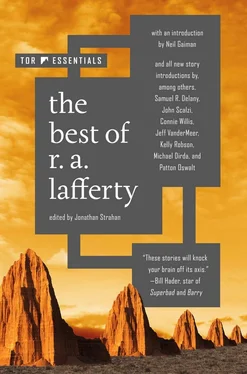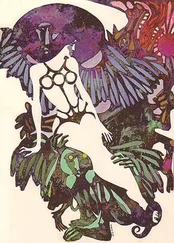“Oh, no, no!” Valery forbade. “Not again. That way is rump of skunk and madness.”
Introduction by Neil Gaiman
This was not the first short story of Lafferty’s I read, nor even the first I fell in love with.
It was, however, the first story I ever took apart, as best I could, to try and work out how he did it.
I would have been about eleven. I didn’t know what an American city block actually was—it was an indeterminate word that meant simply a region, as far as I was concerned. I came from towns and cities with winding, random streets. But I loved the story. It was a shaggy dog story without a punch line, a tall tale without apparent conflict in which all that happened was that two friends walked around a block, and talked to people they found. A letter was dictated. It was about new people coming in, about immigrants, about people working hard and moving on. It was about taking the extraordinary for granted. And I loved the way the words worked.
So I read it, and I reread it, and I read it aloud, and I tried to understand it. I would never know what a Dort Glide was (nor, I suspected, did Lafferty), but I felt that, if I could understand how this short story was built and constructed, I would understand how to write.
I loved the way the people in the shanties spoke. I wanted to speak like the typist, or her sister in the bar. I hoped one day to be able to say, “See how foxy I turn all your questions,” but I never had an opportunity to. I only had one tongue, so to reply, “With my other tongue” was also right out.
Coming back to it as an adult, and I have read it every year or so, I find that I love it as much as I ever did. It’s cockeyed and joyful, but it’s also a glorious, blue-collar, low-rent story about a block in Oklahoma where the people arriving just want to fit in. It’s about immigration, and about what people bring to the places they visit. It’s about revealing secrets.
And it’s a writer’s story, too, about the places that ideas come from. I imagine Ray Lafferty walking past a tin shack he had not noticed before, on his way to a local bar, and having a story in his head by the time that he returned home that night.
There were a lot of funny people in that block.
“You ever walk down that street?” Art Slick asked Jim Boomer, who had just come onto him there.
“Not since I was a boy. After the overall factory burned down, there was a faith healer had his tent pitched there one summer. The street’s just one block long and it dead-ends on the railroad embankment. Nothing but a bunch of shanties and weed-filled lots. The shanties looked different today, though, and there seem to be more of them. I thought they pulled them all down a few months ago.”
“Jim, I’ve been watching that first little building for two hours. There was a tractor-truck there this morning with a forty-foot trailer, and it loaded out of that little shanty. Cartons about eight inches by eight inches by three feet came down that chute. They weighed about thirty-five pounds each from the way the men handled them. Jim, they filled that trailer up with them, and then pulled it off.”
“What’s wrong with that, Art?”
“Jim, I said they filled that trailer up. From the drag on it it had about a sixty-thousand-pound load when it pulled out. They loaded a carton every three and a half seconds for two hours; that’s two thousand cartons.”
“Sure, lots of trailers run over the load limit nowadays; they don’t enforce it very well.”
“Jim, that shack’s no more than a cracker box seven feet on a side. Half of it is taken up by a door, and inside a man in a chair behind a small table. You couldn’t get anything else in that half. The other half is taken up by whatever that chute comes out of. You could pack six of those little shacks on that trailer.”
“Let’s measure it,” Jim Boomer said. “Maybe it’s bigger than it looks.” The shack had a sign on it: Make Sell Ship Anything Cut Price . Jim Boomer measured the building with an old steel tape. The shack was a seven-foot cube, and there were no hidden places. It was set up on a few piers of broken bricks, and you could see under it.
“Sell you a new fifty-foot steel tape for a dollar,” said the man in the chair in the little shack. “Throw that old one away.” The man pulled a steel tape out of a drawer of his table-desk, though Art Slick was sure it had been a plain flat-top table with no place for a drawer.
“Fully retractable, rhodium-plated, Dort glide, Ramsey swivel, and it forms its own carrying case. One dollar,” the man said.
Jim Boomer paid him a dollar for it. “How many of them you got?”
“I can have a hundred thousand ready to load out in ten minutes,” the man said. “Eighty-eight cents each in hundred thousand lots.”
“Was that a trailer-load of steel tapes you shipped out this morning?” Art asked the man.
“No, that must have been something else. This is the first steel tape I ever made. Just got the idea when I saw you measuring my shack with that old beat-up one.”
Art Slick and Jim Boomer went to the run-down building next door. It was smaller, about a six-foot cube, and the sign said Public Stenographer . The clatter of a typewriter was coming from it, but the noise stopped when they opened the door.
A dark pretty girl was sitting in a chair before a small table. There was nothing else in the room, and no typewriter.
“I thought I heard a typewriter in here,” Art said.
“Oh, that is me.” The girl smiled. “Sometimes I amuse myself make typewriter noises like a public stenographer is supposed to.”
“What would you do if someone came in to have some typing done?”
“What are you think? I do it of course.”
“Could you type a letter for me?”
“Sure is can, man friend, two bits a page, good work, carbon copy, envelope and stamp.”
“Ah, let’s see how you do it. I will dictate to you while you type.”
“You dictate first. Then I write. No sense mix up two things at one time.”
Art dictated a long and involved letter that he had been meaning to write for several days. He felt like a fool droning it to the girl as she filed her nails. “Why is public stenographer always sit filing her nails?” she asked as Art droned. “But I try to do it right, file them down, grow them out again, then file them down some more. Been doing it all morning. It seems silly.”
“Ah—that is all,” Art said when he had finished dictating.
“Not P.S. Love and Kisses?” the girl asked.
“Hardly. It’s a business letter to a person I barely know.”
“I always say P.S. Love and Kisses to persons I barely know,” the girl said. “Your letter will make three pages, six bits. Please you both step outside about ten seconds and I write it. Can’t do it when you watch.” She pushed them out and closed the door.
Then there was silence.
“What are you doing in there, girl?” Art called.
“Want I sell you a memory course too? You forget already? I type a letter,” the girl called.
“But I don’t hear a typewriter going.”
“What is? You want verisimilitude too? I should charge extra.” There was a giggle, and then the sound of very rapid typing for about five seconds.
The girl opened the door and handed Art the three-page letter. It was typed perfectly, of course.
“There is something a little odd about this,” Art said.
“Oh? The ungrammar of the letter is your own, sir. Should I have correct?”
“No. It is something else. Tell me the truth, girl: how does the man next door ship out trailer-loads of material from a building ten times too small to hold the stuff?”
Читать дальше




![Рафаэль Лафферти - Дни, полные любви и смерти. Лучшее [сборник litres]](/books/385123/rafael-lafferti-dni-polnye-lyubvi-i-smerti-luchshe-thumb.webp)
![Рафаэль Лафферти - Лучшее [Сборник фантастических рассказов]](/books/401500/rafael-lafferti-luchshee-sbornik-fantasticheskih-ra-thumb.webp)